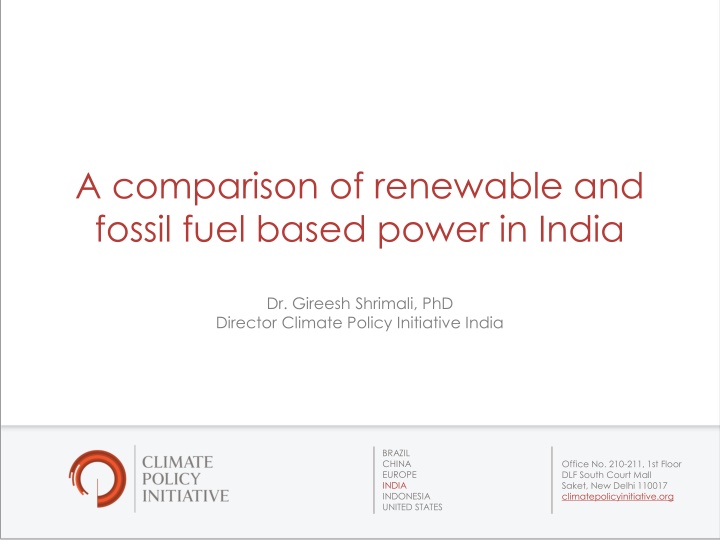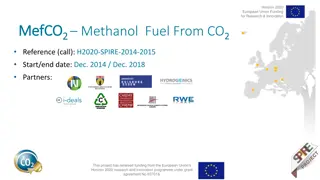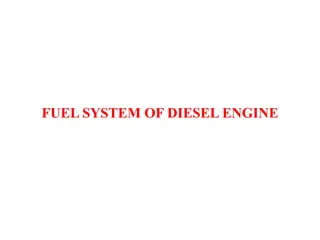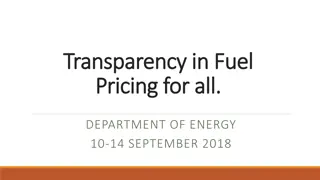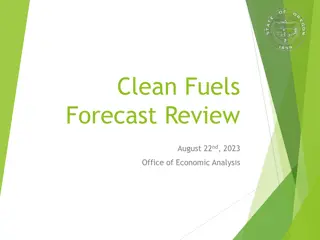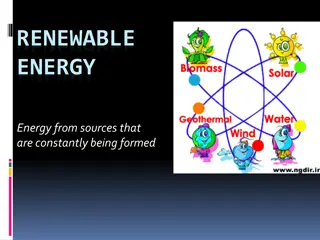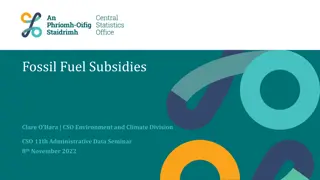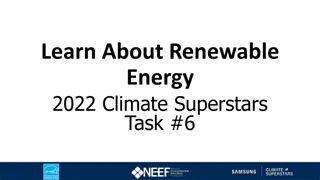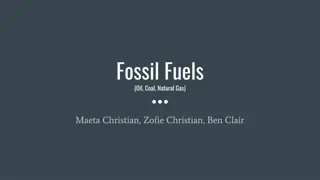Comparative Analysis of Renewable vs. Fossil Fuel Power in India
The comparison between renewable and fossil fuel-based power in India reveals that the renewable energy sector has historically shown lower risk and higher returns than the fossil fuel sector. Investors perceive renewable energy investments to be less risky, with solar being seen as less risky than wind. Important risk factors include counterparty, grid, and financial risks, with counterparty risk being the most significant. Overall, renewable energy power has been a more lucrative investment option in India.
Uploaded on Oct 03, 2024 | 2 Views
Download Presentation

Please find below an Image/Link to download the presentation.
The content on the website is provided AS IS for your information and personal use only. It may not be sold, licensed, or shared on other websites without obtaining consent from the author.If you encounter any issues during the download, it is possible that the publisher has removed the file from their server.
You are allowed to download the files provided on this website for personal or commercial use, subject to the condition that they are used lawfully. All files are the property of their respective owners.
The content on the website is provided AS IS for your information and personal use only. It may not be sold, licensed, or shared on other websites without obtaining consent from the author.
E N D
Presentation Transcript
A comparison of renewable and fossil fuel based power in India Dr. Gireesh Shrimali, PhD Director Climate Policy Initiative India BRAZIL CHINA EUROPE INDIA INDONESIA UNITED STATES Office No. 210-211, 1st Floor DLF South Court Mall Saket, New Delhi 110017 climatepolicyinitiative.org 1
Risk & returns: Historical analysis of listed equity The renewable energy power sector has been less risky than the fossil fuel power sector. The listed renewable energy power sector has historically exhibited, ex post, approx. half (47%) as much systematic risk as the listed fossil fuel power sector. Renewable energy power has been a more lucrative investment than fossil fuel power. Renewable energy power portfolios have historically shown more attractive investment characteristics including, on average, 12% higher annual returns, 20% lower annual volatility, and 61% higher risk-adjusted returns. Returns for both renewable energy and fossil fuel power companies are robustly correlated with the market returns. Using econometric methods, We were unable to determine whether others relevant factors such as company size, value, leverage, coal prices, rupee exchange rate and term premium are robustly priced into the stock returns. Figure 1: Unlevered betas for the Renewable and Fossil Fuels power sectors Figure 2: Historical variation of Sharpe ratio for the Renewable IPP and Fossil Fuel IPP indices 3
Risk & returns: Investor perception of unlisted debt/equity Investors perceive renewable energy power investments to be less risky than fossil fuel power investments too. The expected returns on debt to the fossil fuel power sector is at least 80 basis points (bps) higher than the renewable energy power sector. Within the renewable energy power sector, solar is perceived as less risky than wind. This may be due to the higher perceived resource risk for wind power over solar power In the fossil fuel power sector, coal is perceived as less risky than natural gas. This may be due to the higher market risk associated with natural gas based power due to insufficient domestic reserves, import dependence, high global prices and lack of transport infrastructure in India. The main risk factors driving the risk perception of both the sectors are common i.e. counterparty, grid, and financial risks. These risks together account for 50% - 54% of the total risk premium. Further, for the fossil fuel power sector, the resource risk and power market risk are also significant, contributing to 26% of the total risk premium. Figure 3: Expected rates of return on debt and equity and the expected weighted average cost of capital for a typical project 4
Risk factors: Investor perception Counterparty risk is the most significant risk. Counterparty risk, related to DISCOM non-payment is the most significant risk, contributing to approx. one quarter (22-27%) of the risk premium for renewable and fossil fuel energy The grid/transmission risk contributes 14% to the risk premium for both sectors. This risk pertains to the inadequacy of the transmission infrastructure to absorb the electricity capable of being generated by the installed capacity. The financial sector risk, related to the inability of project sponsors to access sufficient equity and debt capital, is the third major driver of risk. Figure 4: Debt financing waterfall for renewable energy power sector Figure 5: Debt financing waterfall for fossil fuel power sector 5
Managing renewable energy integration through flexible coal 6
Managing renewable energy will require increased flexibility in the system Following Reserves We plotted the load curves for 2017, 2022 and 2027. We established ramp up/down rates using the net load method. The largest ramping requirement is during 17:00 hours to 19:00 hours In 2017 ramping up requirement is 13.27 GW By 2027 the ramping requirement would be 75.05GW Regulating reserves can be calculated using statistical properties of the net load curve Event base reserves would need simulations, such as in ETC GWh 2017 140 130 120 110 100 90 0 1 2 3 4 5 6 7 8 9 10 11 12 13 14 15 16 17 18 19 20 21 22 23 Hours Net Load Load GWh 2022 200 150 100 50 0 0 1 2 3 4 5 6 7 8 9 10 11 12 13 14 15 16 17 18 19 20 21 22 23 Hours Net Load Load GWh 2027 300 250 200 150 100 50 0 0 1 2 3 4 5 6 7 8 9 10 11 12 13 14 15 16 17 18 19 20 21 22 23 Hours Net Load Load 7
A complicating issue is the likely stranding of coal based plants. Stranded coal assets compared to total coal assets and PLF 350 62% Most of the coal-based units in 2017 are operating at an average plant load factor (PLF) of ~61%; this may fall to ~50% by 2022. 60% 60% 300 322 60% 308 294 281 250 57% 268 58% 57% 256 56% 245 56% 200 223 56% 213 204 55% 56% 195 55% 186 54% 54% 150 53% 105 102 99 97 117 54% 87 100 73 70 70 95 67 63 52% 50 - 50% Stranded coal assets Total Coal capacity PLF Since a coal plant becomes economically unviable (i.e. stranded) at a PLF of 52%, at least 1/3rd of the installed coal capacity is likely to be stranded during 2017-2027. 8
Cost (NPV) Implications to convert a baseload coal plant into a flexible coal plant The additional cost of converting a baseload coal plant into a flexible plant can be in the range of 4.5%-10%* of the total project cost (NPV) of the baseload coal plant: Technical upgradation can increase capital expenditure by up to 24% of benchmark fixed cost Modified operational expenses and maintenance to perform flexible operations can increase fixed cost by up to 0.80%. Reduced life due to flexible operation will lead to loss of return on equity which will increase the fixed cost. Lower plant load factors can increase variable cost by up to 9.5% of levelized variable costs. Incremental % Cost (NPV comparison) of converting a baseload coal plant into flexible plant 30.0% 2.3% 25.0% 0.80% 20.0% 15.0% 24.0% 10.0% 5.0% 9.95% 4% 0.0% Incremental Fixed Cost (% over baseload fixed cost in NPV) Incremental Variable Cost (% over baseload variable cost in NPV) Total Incremental Cost (% over total project cost in NPV) Total incremental (%) cost Incremental (%) cost due to reduced PLF levels Incremental (%) cost due to loss in ROE due to reduced project life Incremental (%) cost due to OPEX 9
Thank you BRAZIL CHINA EUROPE INDIA INDONESIA UNITED STATES Office No. 210-211, 1st Floor DLF South Court Mall Saket, New Delhi 110017 climatepolicyinitiative.org 10
Risk & returns: Historical analysis of listed equity (Methodology) Market-cap weighted, annual adjusted indices created for listed equity in the Renewable IPP and Fossil Fuel IPP sectors, using the MSCI Global Industrial Classification System for classification. According to the GICS classification system, companies with predominantly renewable-based portfolios were categorized as belonging to the Renewable index, and those with primarily conventional energy based portfolios (including hydro) were categorized in the Fossils index As per the Capital Asset Pricing Model approach, unlevered beta of these indices was treated as metric for systematic risk, and compared for the period 2006-2016 Sharpe Ratio* (ratio of excess returns over the market returns to the portfolio volatility) was used as a metric for comparing the risk-adjusted returns of these two portfolios *In practice, we compared the Modified Sharpe Ratio to account for years with negative excess returns 12
Risk & returns: Historical analysis of listed equity (Methodology) Predominantly Fossil Fuel Based Power Predominantly Renewable Energy Based Power Company Name Market Capitalization 2017 (USDmm, Historical rate) 2,261.7 Company Name Market Capitalization 2017 (USDmm, Historical rate) 6.1 Adani Power Limited Advance Metering Technology Limited Entegra Limited Elango Industries Limited 0.2 8.9 Gujarat Industries Power Company Limited JSW Energy Limited 237.9 Globus Power Generation Limited Ind Renewable Energy Limited Indowind Energy Limited 34.2 1,555.9 0.7 NLC India Limited 2,435.8 5.7 NTPC Limited 20,006.8 K.P. Energy Limited 19.1 RattanIndia Infrastructure Limited RattanIndia Power Limited 68.5 Karma Energy Limited 7.4 318.3 Kintech Renewables Limited Morgan Ventures Limited - Reliance Power Limited 2,004.4 1.8 Suryachakra Power Corporation Limited Tata Power 5.1 Orient Green Power Company Limited S. E. Power Limited 112.5 3,765.0 8.0 Sun Source (India) Limited 0.7 Table 1: Listed independent power producers in India as of May, 2017 13
Risk factors: Investor perception (Methodology) Methodology derived from the De-risking Renewable Energy framework developed by UNDP in 2013 Structured interviews conducted with 16 direct investors (debt and equity; renewable and fossil fuel based) in power sector projects Interviewees were asked their expectations on returns on debt and equity for four technologies: solar PV, wind, coal and natural gas The aggregated results were used to make inferences about the investor risk perception of these technologies Further, relevant interviewees were asked to rate eight risk factors on their likelihood of occurrence and financial impact on occurrence This data was used to determine percentage contributions of constituent risk factors to the total debt risk premium (cost of debt best-in-class cost of debt) Accordingly, a debt financing waterfall was created for both sectors, which shows the iterative contribution of each constituent risk factor to the total risk premium 14
Risk factors: Investor perception (Sample) Number of interviewers approached 76 16 Number of respondents 11 Renewable energy investment 8 Fossil Fuel energy investment 8 Debt investors 9 Equity investors Grants ,mezzanine Other investment vehicles Table 2: Interviewees by asset class and area of expertise 15
Backup slides - Managing renewable energy integration through flexible coal in India 16
India ambitious targets will result in significant share of power generation by renewable energy Renewable Energy 2017, 2022, 2027 India s renewable push via a variety of policy mechanisms, at the end of 2017 the installed capacity of wind and solar stood at 30GW and 16GW, respectively. 160.0 200.0 100.0 100.0 150.0 60.0 100.0 32.7 14.7 10.0 10.0 50.0 8.3 5.0 5.0 4.4 - 2017 wind 2022 2027 solar SHP Biomass+WTE Steadily increasing share of renewable energy in electricity mix, Expected to go from 9% in 2017 to 23% in 2027 Share of renewables in Electricity Generation Mix 80% 70% 75% 60% 64% 63% 50% 40% 23% 30% 19% 20% 9% 10% 0% 2017 2022 2027 Share of RE in Electricity Generation mix Share of Coal in Electricity Generation mix 17
Formula for Cost of Conversion of Coal Plant into a Flexible Plant (Incremental) Cost of Flexibility is sum of Loss due to lower PLF leading to higher primary fuel cost (A) Extra fixed cost required to convert a coal plant into a technical flexible plant(B) Loss in ROE due to the reduced life of the plant due to flexible operation (C) Where, A = Primary Fuel Cost at PLF of a flexible plant (PLF 40%-60% range) - Primary Fuel Cost at PLF of 60% (new normal); B = Interest rate for the new loan + Depreciation of the capex incurred + ROE expected after the retrofitting; C = ROE component of the recovery cost lost due to reduced life of the plant 18
Assumptions for Cost of Conversion of Coal Plant into a Flexible Plant Fixed cost of a baseload plant will be recovered in full under the flexibility mode as well. Now when the plant is designed to operate as a flexible coal plant, the PLF will remain lower than 60% (and PAF will remain at normative levels i.e. 85%). The compensation required to recover cost will be equivalent to the increase cost of primary fuel when the PLF goes below 60%. We have considered 60% as the baseline PLF for the calculation of this component because the new normal of PLF in the industry is 60%. The additional Capex required for retrofitting to convert the plant from baseload plant to a flexible plant will be recovered as the additional fixed cost in the form of interest cost+depreciation+ROE+OPEX. 19
Assumptions for Incremental Cost Calculation Parameters Baseload Coal Plant 85% 60% Flexible Plant Comments Plant Availability Factor (PAF) Plant Load Factor (PLF) 85% 40%-55% We assume that a flexible coal plant would operate in the range of 40%-60% PLF. Due to increased frequency of ramping up and down of the plant, the life of the plant gets reduced. We assumed the same debt cost on the extra capex incurred to convert the baseload plant into a technically flexible plant. We assumed the same ROE on the extra capex incurred to convert the baseload plant into a technically flexible plant. Total Plant Life (Yrs) 40 30 Interest Rate 10% 10% Return on Equity (ROE) 15.50% 15.50% Initial Capex for Baseload Plant (INR Cr/MW) Additional Capex to convert the plant into a flexible plant (INR Cr/MW) Additional Opex for flexible operation Flexibility Implementation Year 12th Year 4.5 Not Applicable Not Applicable 0.70-2.3 Source: German case study We have taken scenarios for the capex number as it can vary from plant to plant Source: German case study NA 2-5% of the existing Opex This is the year when the baseload plant is retrofitted to work as a flexible plant. We have taken 2 scenarios for this: 12th Yr and 15th Yr. BRAZIL CHINA EUROPE INDIA INDONESIA UNITED STATES 235 Montgomery St. 13th Floor San Francisco, CA 94104, USA climatepolicyinitiative.org
Cost (LCOE) Implications to convert a baseload coal plant into a flexible coal plant The incremental cost can be 8%-22% of the total LCOE of a baseload coal plant. Incremental % Cost (LCOE comparison) of converting a baseload coal plant into flexible plant 60.00% 50.00% 4.09% 0.99% 40.00% 30.00% 42.92% 20.00% 21.89% 10.00% 9.56% 0.00% Incremental fixed cost (INR/kWh) - (% over fixed cost of baseload plant in levelized terms) Incremental variable cost (INR/kWh) - (% over variable cost of baseload plant in levelized terms) Total Incremental cost (INR/kWh) - (% over total cost of baseload plant in levelized terms) Total incremental (%) levelized cost Incremental (%) levelized cost due to reduced PLF levels Incremental (%) levelized cost due to loss in ROE due to reduced project life 21
Other Key Results It is technically feasible for plant to operate under lower PLFs of 40-60% Required additional capex can be in the range of INR 0.70-2.3 Cr/MW May lead to reduction in the life of the plant from 40 years to 35 or 30 years The upfront investment costs of lithium ion battery and pumped hydro, the cleaner flexibility options, are 500-2000% times and 400-1800%, respectively, costlier than the incremental cost required for converting a baseload coal plant into a flexible plant respectively. The utilization of coal plants as flexible plants will save CO2 emission of approximately 0.11 million tons/MW in absolute terms. Lowering minimum PLF of coal plants (down to 40%) is the biggest driver to reduce RE curtailment from 3.5% down to 0.76%. 22
Flexible coal should be used a short-term solution To ensure a viable conversion of baseload coal plants to a flexible plants, the incremental costs would require fair compensation to the investors and project developers. Flexible coal power should ideally be procured using appropriate market mechanisms, such as capacity auctions to ensure the cost-effectiveness. We emphasize that we are not recommending that flexible coal is a long-term solution. It is important that the cost of cleaner flexibility options, such as batteries, come down as soon as possible so that India can transition to a low-carbon electricity system in an accelerated manner. 23
